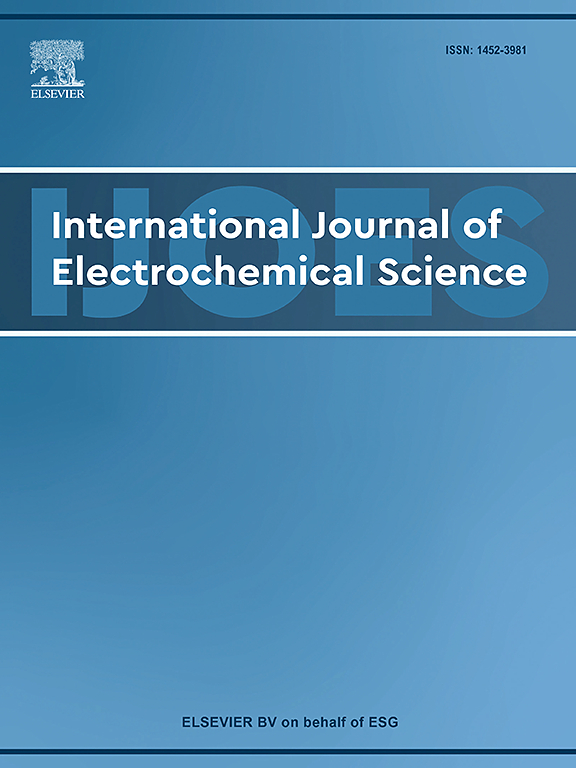Biosynthesis of Pd@CuCo₂O₄ nanocomposites for sensitive electrochemical detection of doxorubicin and their biological activities
IF 2.4
4区 化学
Q4 ELECTROCHEMISTRY
International Journal of Electrochemical Science
Pub Date : 2025-09-18
DOI:10.1016/j.ijoes.2025.101185
引用次数: 0
Abstract
This study used Acalypha indica leaf extract to synthesize CuCo2O4 and Pd@CuCo2O4 nanocomposites. The biosynthesised nanomaterials were employed for the electrochemical detection of the anticancer drug doxorubicin and were further evaluated for their antibacterial and antioxidant activities. The biologically synthesized nanoparticles were thoroughly characterized through a combination of analytical techniques, including X-ray diffraction, scanning electron microscopy, energy-dispersive X-ray spectroscopy, Fourier-transform infrared spectroscopy, and UV–Visible spectroscopy. The synthesized Pd@CuCo₂O₄ nanocomposite demonstrated outstanding sensitivity, selectivity, and accuracy in the electrochemical detection of doxorubicin using differential pulse voltammetry. The Pd@CuCo₂O₄ nanocatalyst facilitated the electrochemical oxidation of doxorubicin, resulting in improved electrode surface functionality and enhanced stability and sensitivity. According to an electrochemical analysis, the developed sensor exhibits a linear response range from 0.05 to 200 µM, with a sensitivity of 0.0225 µM and a detection limit of 30 nM. The electrochemical sensing of doxorubicin can be significantly enhanced through the biosynthesis of Pd@CuCo2O4. This process is notable for its eco-benign nature, simplicity, and high efficiency, ultimately enabling more precise and targeted detection strategies for the anticancer drug. Furthermore, the antibacterial and antioxidant capabilities of both CuCo₂O₄ and Pd@CuCo₂O₄ nanocatalysts were evaluated.
Pd@CuCo₂O₄纳米复合材料的生物合成及其对阿霉素的灵敏电化学检测及其生物活性
本研究以猕猴桃叶提取物为原料合成CuCo2O4和Pd@CuCo2O4纳米复合材料。将生物合成的纳米材料用于抗癌药物阿霉素的电化学检测,并进一步评价其抗菌和抗氧化活性。通过x射线衍射、扫描电子显微镜、能量色散x射线光谱学、傅里叶变换红外光谱学和紫外可见光谱学等分析技术,对生物合成的纳米颗粒进行了全面的表征。合成的Pd@CuCo₂O₄纳米复合材料在差分脉冲伏安法电化学检测阿霉素中表现出优异的灵敏度、选择性和准确性。Pd@CuCo₂O₄纳米催化剂促进了阿霉素的电化学氧化,从而改善了电极的表面功能,增强了稳定性和灵敏度。电化学分析表明,该传感器的线性响应范围为0.05 ~ 200 µM,灵敏度为0.0225 µM,检出限为30 nM。通过生物合成Pd@CuCo2O4可以显著增强阿霉素的电化学传感能力。这一过程以其生态、简单和高效率而闻名,最终使抗癌药物的检测策略更加精确和有针对性。此外,还对CuCo₂O₄和Pd@CuCo₂O₄纳米催化剂的抗菌和抗氧化能力进行了评价。
本文章由计算机程序翻译,如有差异,请以英文原文为准。
求助全文
约1分钟内获得全文
求助全文
来源期刊
CiteScore
3.00
自引率
20.00%
发文量
714
审稿时长
2.6 months
期刊介绍:
International Journal of Electrochemical Science is a peer-reviewed, open access journal that publishes original research articles, short communications as well as review articles in all areas of electrochemistry: Scope - Theoretical and Computational Electrochemistry - Processes on Electrodes - Electroanalytical Chemistry and Sensor Science - Corrosion - Electrochemical Energy Conversion and Storage - Electrochemical Engineering - Coatings - Electrochemical Synthesis - Bioelectrochemistry - Molecular Electrochemistry

 求助内容:
求助内容: 应助结果提醒方式:
应助结果提醒方式:


